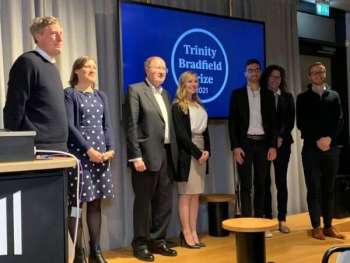
We are excited to announce the 8 finalists of The Trinity Bradfield Prize.
These teams will be pitching at the final on the 24th of January, at The Bradfield Centre. If you would like to attend, there are around 10 seats left before we have a full house. Registration is here.
We would also like to extend our thanks and appreciation to everyone that took the time to apply. The judges commented how high the standard of entries was again this year, so don't be too disheartened if you didn't make it through to the final, and please consider re-entering when 2023 applications open later in the year.
The finalists:
Withdata
We plan to create a cloud platform that enables non-expert users to gain data insights, scenario forecasting, and plausible solutions from Bayesian inference via innovative model-centric data analysis. Our solution can reduce the cost and complexity of data modelling and the coding process, boosting enterprises' productivity, management and business.
OvartiX
OvartiX is a preclinical-stage biotech company that utilizes a multi-omics bioinformatic approach to identify biomarkers that influence reproductive ageing and fertility in women, and target these within in vitro and in vivo techniques capable of screening compounds that will predict, prolong fertility and enhance the success of assisted reproductive technology.
Evoralis
Evoralis has a mission to enable true and sustainable recycling of synthetic polymers. It uses a unique ultrahigh-throughput screening platform to find and improve enzymes that can break down plastics into their building-blocks. Biocatalysts can be tested at unprecedented speed, making the discovery of plastic-degrading enzymes ~ 1,000 times faster.
GAVE
Use soft magnetic nanocrystalline material as an energy transfer medium to achieve efficient and reliable EV wireless charging.
Vuala
Vuala's solution automatically separates and liquifies food waste from other wastes, turning them into raw material for biogas and animal feed production within hours on site. In return we save 95% logistic and labour cost while reducing 75% carbon emission.
Oxonium Energy
Our technology can serve as the basis for high-voltage (> 1.5 V), high energy-density and air-stable aqueous redox flow batteries for grid-scale energy storage. These features enable substantially lower energy costs relative to other RFB technologies. The devices involved can be adapted for carbon capture and power-to-X applications.
Rapid Identification of Pathogens and AMR directly from Clinical Samples
Current methods for bacterial identification take days to produce a diagnosis which could inform the treatment of patients. This lag results in inappropriate prescription of antibiotics, one factor giving rise to the threat of antimicrobial resistances. We have developed a rapid method, producing a diagnosis in less than 30 minutes.
AR-X Photonics
Existing AR/VR headsets cause nausea, headache, dizziness like problems. As a result, even with such a huge potential it is yet to take-off. Our optics based on research at Cambridge University fundamentally solves the problem. We do so by projecting image right at retina to create always in-focus image.
Good luck to all the finalists and see you on the 24th.
